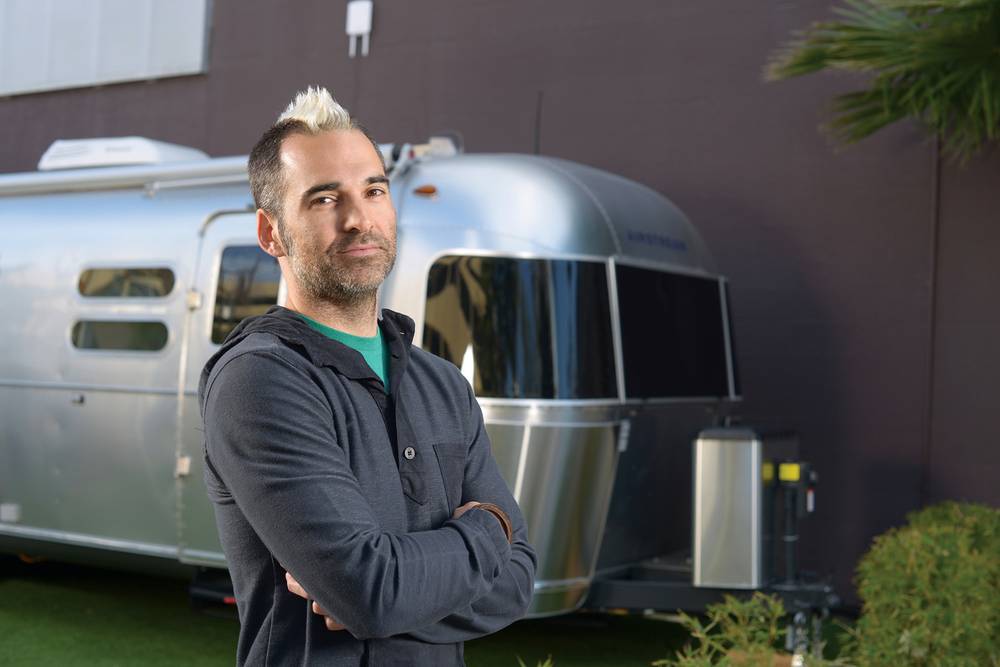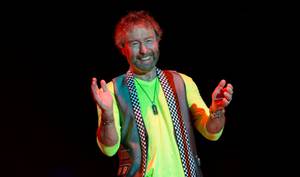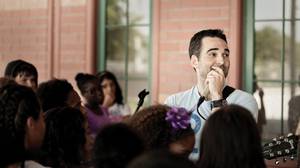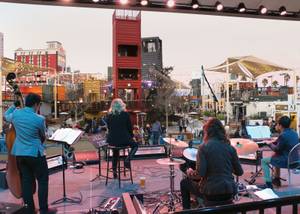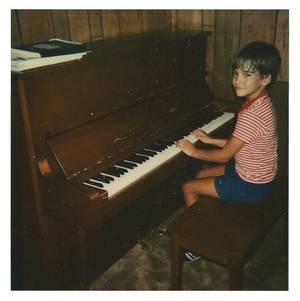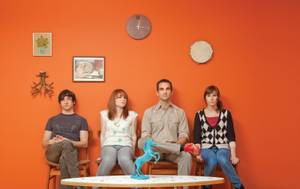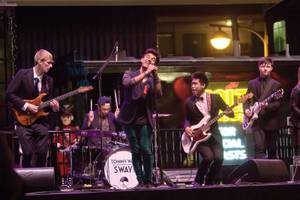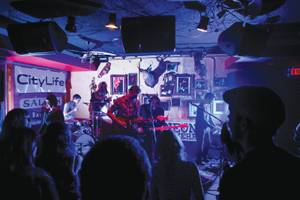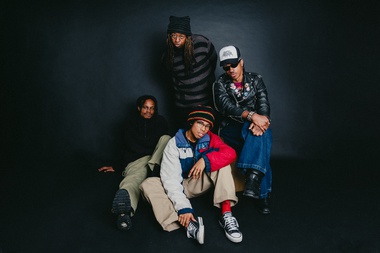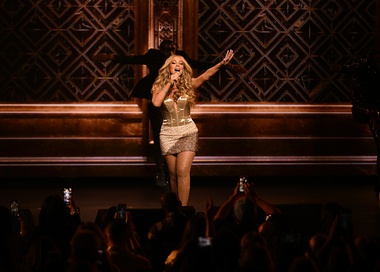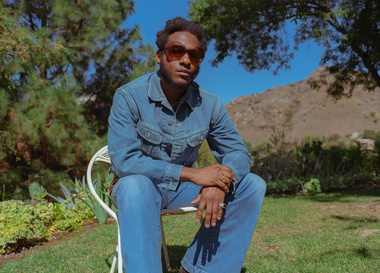Ashton Allen looks like a guy who just got back from Hawaii. He’s tan, sporting a freshly bleached, surfer-like haircut with his salt ’n’ pepper temples shorn down to the scalp, and he’s glowing like he just spent a week in paradise with his girlfriend. As he chows down a burrito, he recounts a flight snafu and the subsequent trip extension, though his ear-to-ear smile implies he was hardly inconvenienced.
The real disruption lies in the sanitized pop beats currently booming from the PA of the Container Park, which is remarkably busy for a midweek afternoon. The 40-year-old Allen faces an interesting quandary: Find the spot with the least amount of music. Allen eyes the sanctuary of an empty shipping bin, destined to be a salon but currently a glorified closet for many drums, congas and other instruments. We dust off some folding chairs, the tape recorder is tested and Madonna is reduced to a faint garble.
We’re interrupted only when the Downtown Project Rangers security team comes in for its percussive apparatus just ahead of the daily children’s drum circle it organizes. It’s easy to assume that Allen, “music guy” for Zappos CEO Tony Hsieh’s Downtown Project and a passionate believer in music education, might be behind the kids’ playing. But he has nothing to do with it—nor did he lift a finger during the planning and execution of the Life Is Beautiful Festival.
In fact, Allen can’t take credit for much of anything—yet. He’s remained behind the scenes since he moved to Las Vegas 13 months ago, reliant on a hard-working four-person team he manages. He says he’s spent six of those months largely “listening” to locals in the music scene, playing mental Tetris with their stories and concerns and his plans to enrich the ever-expanding musical playground Downtown. When you ask him about those plans, however, he mostly buttons up.
But unlike Downtown Project’s general zipped-lip demeanor, you get the sense Allen simply fears an early jinx would permanently destroy his credibility. In fact, he actually seems like a guy you can trust.
After a flurry of activity and energy transformed Fremont East and the nearby Arts District into a music hub between 2007 and 2010, the Downtown scene has valleyed into stagnancy. But it recently received a small jolt from Downtown Project, Hsieh’s $350-million entrepreneurial/urban development endeavor, which took over Gold Spike in 2013, stripping out the slot machines and transforming it into a local clubhouse with a three-night weekly calendar of genre-spanning live bands and DJs, almost all from Las Vegas. That offering is topped only by DTP-funded Container Park’s daily complement of local-dominant artists on its outdoor stage, with more strings and woodwinds during the day and plenty of contemporary tuneage in the evening.
Allen claims that between Thanksgiving and Christmas last year, DTP paid local acts more than $60,000 for gigs at the two venues, casually adding that it was a “step in the right direction, financially.” And speaking of financials, Downtown Project is a major funder of Life Is Beautiful, too.
If the music community wasn’t already leery of Zappos’ perceived power grab and particularly Downtown Project’s potential footprint, it definitely raised its collective eyebrow when DTP snapped up the Bunkhouse—arguably the most beloved and consistently booked Fremont venue—before its closure last summer for renovations.
Some of that skepticism is healthy, given the speed of DTP’s rise and influence, and some of it is knee-jerk, paranoid and tribal. A good chunk of the Downtown Project force came from elsewhere, including Allen, and few in the music scene have met or even heard of the Florida ex-pat, who just may have been the slender, scruffy guy next to you at the last A Crowd of Small Adventures show.
He was most definitely that guy at the first Life Is Beautiful music showcase in June, when LIB’s own music guru, Craig Nyman, introduced me to Allen. Over the past seven months, we’ve grabbed a few lunches and a handful of beers, I’ve joined him in Hsieh’s Pretty Woman box suite at the Smith Center and tagged along on a tour of Las Vegas Academy in the hopes of getting to know him. Here’s what we learned about the music scene’s newest enthusiast—and why we think he should be given a chance to prove himself to Las Vegas.
Ashton Allen has always been immersed in music. He began piano lessons at 4, and competed in recitals during junior high and high school. He transitioned into rock in his late teens, becoming the bassist of a septet called Big Sky that toured the U.S. for 11 years—including a 1999 EAT’M conference showcase at the old Desert Inn—before giving up the chase for a record deal.
Allen would finally score one himself as a singer-songwriter with southeastern imprint Livewire, releasing the raw 2005 album Dewdrops to some acclaim, but battling the label until it folded. Desperation and debt bore the do-or-die Rock Salt Recordings, a for-hire music production enterprise he started with longtime friend/collaborator Devin Moore. By the time he formed the alt-happy creative outlet Rabbit with Moore, Allen had rebounded and extended his musical career. And then he met Tony Hsieh.
In 2010, a random offer for Rabbit to play a venture-capitalist conference in Hawaii led to a chance encounter with Hsieh, who complimented the band and invited them to hang out.
A friendship ensued, and soon Hsieh was inviting the musicians to Vegas for regular visits—and imploring them to move to town. But Allen resisted, despite finding himself drawn to Downtown and curious about its peculiar music scene.
“It was exciting and intimidating, because as I was noticing the culture of Downtown and getting exposed to it, I also felt it was a tight-knit, earn-your-stripes kind of [scene],” Allen says.
When Rabbit returned for an extended, exploratory stay in 2012, he says, “Tony introduced me to anyone I didn’t know as ‘the guy working on the music project for Downtown.’ I remember pulling him aside and saying, ‘Why are you saying that? No. 1, I’m not that guy yet, and No. 2, I don’t even live here!’”
Hsieh saw more in Allen. “It was a combination of Ashton’s passion and appreciation for all types of music, combined with his business experience and personality,” Hsieh says.
Meanwhile, the rest of the Downtown Project and his new friends pressed Allen for his plans. “Everyone was like, ‘Oh, are you auditioning Vegas?’” Allen recalls. “Actually, I said, ‘I think we’re auditioning for Vegas.’ If we can’t contribute something here, then we shouldn’t be here.”
Over the course of three months, Allen found his purpose. He saw opportunity in a long-leash position where he was free to define his duties and develop his vision—one born from his own hardscrabble, life-in-a-van past and lessons learned from living in small-but-thriving music scenes. He wanted to ensure there would be young musicians to occupy any potential infrastructure expansion, and to grow the scene into one people would travel to experience, like Austin or Portland or Brooklyn.
Now came the hard part—encountering musicians who were already distrustful of the Downtown Project.
Even before he officially joined the Downtown Project, Allen’s networking recon had brought him fairly up to speed with the Vegas music community. His reluctance to jump at Hsieh’s first or second beckonings meant he got to better know Downtown before he finally inhabited it, and he quickly learned that the Downtown music scene lacked all-ages experiences, that some of its venues skimped on performance payments and that it suffered from disunity—mostly along genre lines—and an enthusiasm gap.
Allen hoped to start off on the right foot by using a skill he’d learned from his piano teacher: active listening. He tried to gauge the temperature of and learn more about the Downtown scene and its players. And he not only respected their evolution, but also their concerns regarding his employer. He knew that for many, he represented the first accessible liaison between them and the Downtown Project, and that if he glossed over their complaints and histories, neither he nor his bosses at the Ogden had a chance at legitimacy within the existing culture.
“I don’t understand what it’s like specifically to have a $350 million privately funded project in my backyard,” Allen says. “I think I don’t have many gifts, but one of them is probably empathy. When I put myself in the position of a local—as best I can—I think to myself ... there were things I hated about my town and things I loved and things in between. Just like the Bunkhouse and the transfer of its ownership, [they were] mine. So I get it.
“I am part of the machine,” he adds. “But I am coming from a music perspective and not a business perspective.”
One local figure Allen sought out was Ronald Corso, musician/producer and owner of the local National SouthWestern imprint. Allen shared what he liked about Corso’s recordings, then asked Corso how he thought Downtown could revive the “scene-building vibe” of five years ago.
“I admit, I gave him some sh*t, like a real townie,” Corso says. “But he asked, and he listened.” It was Corso who detailed how Fremont East sprung to life chiefly due to the acts that populated its venues and the fans who regularly supported them, making the area attractive for an entity like Downtown Project in the first place.
“I think it’s great that somebody with influence at DTP gets that, and is out asking those kinds of questions and listening to the answers,” Corso adds. “Hopefully DTP is listening to him the way he’s listened to people in the music community.”
Besides lending his ear, Allen also befriended some of the musicians—and even employed one: scene veteran Aly (Prudence) Unna, who became his assistant music programmer at Gold Spike.
“As a Las Vegas music scene native, I felt given the opportunity to curate something special for my community,” Unna says. “Ashton and I were perfect strangers, but seemed to have a connectivity already intact in our absolute passion for music. … Ashton has the heart of a musician—and that matters.”
Corso has long used social media to bemoan the way Downtown has empowered the out-of-towner, noting that homegrown talent could serve the community just as well, if not better. Which might explain why Allen tried so hard to see and hear the Las Vegas perspective.
“If I had to step into their shoes and picture myself being here ... my thought is, It’s their responsibility to talk to me. This is my neighborhood. This is my Bunkhouse. I was here first,” Allen says. “And again, I think there was that uncomfortable opportunity on the music side to step into that space a little bit—and continue to step into that space—and listen a lot.”
In some ways, being from elsewhere actually liberates Allen nearly as much as his lack of a job description does. It means he’s mostly free from presumptions, and as evidenced by Allen’s meeting with Corso, he wants to learn from Vegas, not to teach it some lesson or dress it up in another city’s drag. And thankfully, Allen doesn’t carry the smugness or entitlement of someone who always rattles on about the cultural Mecca from where he came. You might even say his Orlando roots mean he understands the strange dynamics of a tourist town.
Locals often dismiss outsider criticism, but Vegas could occasionally use a fresh, unbiased pair of eyes—as long as the observer keeps things in context.
We’re perched above the Reynolds Hall orchestra section in a suite at the Smith Center. The program is World Blues, which includes multi-instrumentalist/ethnomusicologist Taj Mahal and a South African guitar prodigy named Vusi Mahlasela. Though our seats would ostensibly enable some quiet conversation, Allen assumes a focus-ahead posture and fixates on the stage the entire time.
Later, he admits he prefers the varied and experiential New Orleans Jazz Fest to the indie-concentrated Coachella, though he enjoys both. In fact, Allen loves jazz, despite having been a full-time rocker for so long. His one day job 17 years ago was at Jazziz magazine in Gainesville, Florida, where he discovered John Coltrane’s Giant Steps.
More recently, he wandered outside of Downtown and happened upon east-side jazz joint Dispensary Lounge—which he affectionately compares to his grandmother’s living room—as well as Eric Shauer’s live, educational Jazz Out of the Box program, also featuring multi-instrumentalist Julian Tanaka. “It blew my mind,” Allen says. “I’m like, how do kids attach themselves to jazz music? I couldn’t understand Coltrane in college.”
Since then, he’s brought jazz to Thursday nights at Gold Spike, though with that venue evolving into more of a party spot, Allen hopes to move the jazz programming to the just-opened Inspire Theater, along with the Ogden’s soon-to-open Scullery bar and its 100-seat black box-type theater, both partnerships between DTP and Downtown entrepreneur Michael Cornthwaite.
Allen also believes other genres need better representation to round out the Downtown musical experience. “One of the first things I was asked when I started working for Downtown Project was, ‘What’s the Vegas sound?’” Allen says. “And I was thinking—being idealistic—how cool would it be if Vegas was known for music as a whole, and not just for metal, punk and indie, but salsa and orchestral and jazz. ... Music spans all of that. I don’t know if that’s possible, but it would be incredible to me if Vegas embraced that concept.”
"Ever taken the Las Vegas Academy tour?” Allen asks me one morning. When we register at the school, he reveals this is his eighth or ninth trek, and you get the feeling he walks every new acquaintance through the Downtown magnet high school, selling them on Vegas’ musical prospects.
He admits LVA is his first Vegas musical love. Not only does the school itself affirm why Allen is so bullish about promoting music and arts instruction in schools, but he marvels at the students’ talents and self-empowerment. He’s emotionally invested in trying to keep them here, which is typically the opposite of what happens when kids leave LVA.
“I know kids graduate that school with the goal of ‘get me out of here,’” Allen says, “but [LVA-schooled] artists like Sabriel and [former Frankie Moreno opener] Tommy Ward are thinking about settling here, and not thinking they’re going to move to New York or LA. They see the promise of what [Downtown] can bring.”
Already, Ward and his throwback pop group Swayd perform regularly at the family-friendly Container Park. LVA hosts some 250 performances every school year, but supplemental exhibitions would give future stars added exposure—and enrich the scene off-campus. “I’m thinking integration here,” Allen says. “The opportunity is incredible.”
Even though DTP currently operates stages at Container Park and Gold Spike, the Bunkhouse will be the group’s first dedicated music venue. Allen wasn’t involved with last year’s purchase, but he’s eager to unveil what he hopes will become a magnet to touring bands—especially the ones that normally skip Vegas—and local artists wanting to reclaim their live-music HQ.
Alas, it remains under renovation, unlikely to open before June. The worst-kept secret in town has been that the place was in considerable disrepair, and DTP had to replace the entire roof. The outdoor stage and sound system will be notable change-outs, too.
The Bunkhouse’s new interior will be largely unrecognizable, though a source says Allen fought to keep the front exterior as intact and native as possible, suggesting that he sees the Bunkhouse as the thin string tying together the local music scene and DTP. Strengthening that connection is DTP’s recruitment of veteran local musician/producer and former restaurant manager Mike Stratton to run Bunkhouse 2.0.
“The Bunkhouse was definitely one of those places where you could run wild creating your own show and take advantage of every element of the place,” remembers Black Camaro singer/guitarist Brian Garth, who worked and played there more than most, and, despite his well-known skepticism, is ready to give DTP the chance to do right by both the venue and music fans.
Allen wants the Bunkhouse to be the place where local bands experiment with event-like shows, more so than in the past.
Other plans for DTP’s live-music expansion include booking “A-list” headliners to play Downtown beyond Life Is Beautiful, which itself could see increased DTP involvement in 2014; a booking/promotions agency modeled after successful enterprises like Transmission Events in Austin to help turn Downtown into a national live-music destination; and intimate “secret” shows featuring touring and local acts, organized by Sofar Sounds.
Optimism cast aside for a second, we’re far from knowing whether the guy with good intentions can deliver for Downtown, or even Downtown Project, for that matter.
The Bunkhouse 2.0 alone represents so much uncertainty—it could easily betray its Downtown-fringe position and play it safe, disillusion music fans expecting the world from the deep-pocketed organization, or fluster local bands not onboard with DTP’s grandiose vision.
Elsewhere, Allen seems welcoming of industry folk and their influence, but that rarely ends well for the artist or community, so buyer beware. And whether his deference to the locals and traditions that precede him becomes a real consideration in his strategies—or signifies lip service to ward off the pitchforks—remains to be seen.
But this much should be said: Locals have long complained about not being heard by DTP, and yet Allen is all ears. He represents the most unique of intermediaries, one who can straddle both the music and business worlds to spark connectedness in a community.
“It’s been uncomfortable but incredibly beneficial to step into that space and go, ‘I’m the guy from Florida, it’s okay for you to ask me who the hell am I,’” he says. “‘Let’s get through that and talk—but more importantly, what is it that you want?’”
For anyone with an inquiry—and any remaining skeptics—he’s listening at [email protected].
